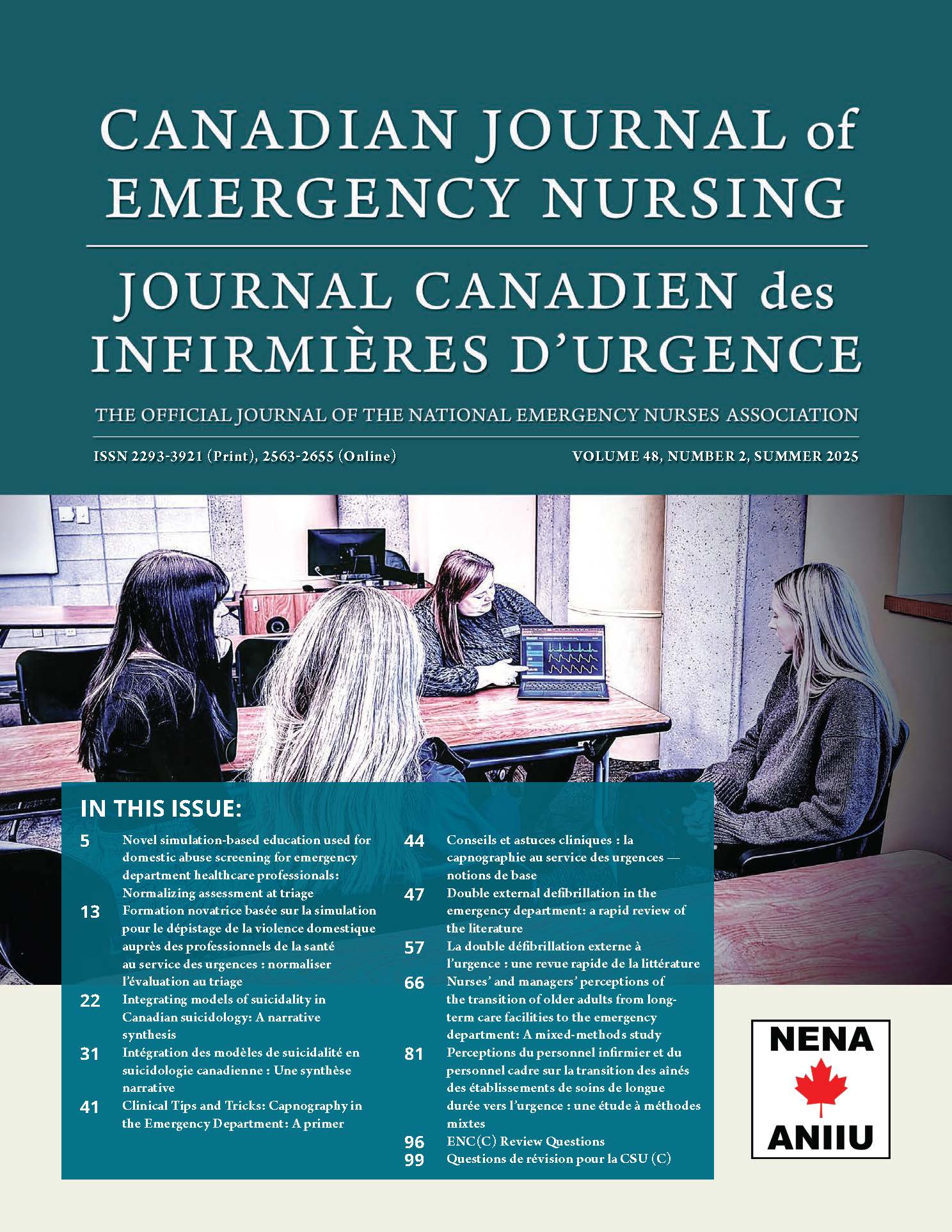Novel simulation-based education used for Domestic Abuse Screening for Emergency Department Healthcare Professionals
Normalizing Assessment at Triage
DOI:
https://doi.org/10.29173/cjen243Keywords:
emergency nurse, Domestic Violence, rural, simulation, trainingAbstract
Purpose: Rural emergency department healthcare professionals are well-positioned to serve as a resource to domestic violence victims but may lack the necessary training to effectively screen for and respond to domestic violence victims. A novel, low fidelity simulation-based education provided an opportunity to increase healthcare professionals’ readiness to screen for domestic violence.
Methods: We facilitated 14 simulations with 181 participants at eight rural sites between September 2022 and June 2023. A multi-method program evaluation was used to assess the impact of the simulation-based education on participants' readiness to screen for domestic violence and their clinical practice. Participants of the simulation were invited to complete a pre and post-simulation survey regarding their experience and perceptions related to screening for domestic violence. Participants were invited to participate in follow-up semi-structured interviews to discuss how simulation-based education has influenced their practice three to nine months following the simulation.
Results: Prior to the simulation-based education participants reported several barriers to screening for domestic violence and a lack of training. Following simulation-based education, a statistically significant increase in readiness to screen for domestic violence was observed, t (102) = 19.43, p <.001, d = 1.91 between the pre- and post-simulation survey scores (n = 103). Through semi-structured interviews (n = 6), two themes were identified: (a) influence on education and (b) the power of simulation-based education.
Conclusions: Simulation-based education is an effective education modality to enhance healthcare professionals’ readiness to screen patients for domestic violence and may positively influence their practice through increased awareness and more consistent screening.
References
Adelman, M., Rosenberg, K. E., & Hobart, M. (2016). Simulations and social empathy: Domestic violence education in the new millennium. Violence Against Women, 22(12),1451-1462. https://doi.org/10.1177/1077801215625850
Alberta Innovates. (2022). A project ethics community consensus initiative (ARECCI) ethics guideline tool. https://arecci.albertainnovates.ca/
Alvarez, C., Fedock, G., Grace, K. T., & Campbell, J. (2017). Provider screening and counselling for intimate partner violence: A systematic review of practices and influencing factors. Trauma, Violence, & Abuse, 18(5), 479-495. https://doi.org/10.1177/1524838016637080
Braun, V., & Clarke, V. (2006). Using thematic analysis in psychology. Qualitative Research in Psychology, 3, 77-101. https://doi.org/10.1191/1478088706qp063oa
Cleak, H., Hunt, G., Hardy, F., Davies, B., & Bell, J. (2021). Health staff responses to domestic and family violence: The case for training to build confidence and skills. Australian Social Work, 74(1), 42-54. https://doi.org/10.1080/0312407X.2020.1808029
Eppich, W., & Cheng, A. (2015). Promoting Excellence and Reflective Learning in Simulation (PEARLS): development and rationale for a blended approach to health care simulation debriefing. Simulation in Healthcare, 10(2), 106-115. https://doi.org/10.1097/SIH.0000000000000072
Jack, S. M., Kimber, M., Davidov, D., Ford-Gilboe, M., Wathen, C. N., McKee, C., Tanaka, M., Boyle, M., Johnston, C., Coben, J., Gasbarro, M., McNaughton, D., O’Brien, R., Olds, D. L., Scribano, P., & MacMillan, H. L. (2021). Nurse-Family Partnership nurses’ attitudes and confidence in identifying and responding to intimate partner violence: An explanatory sequential mixed methods evaluation. Journal of Advanced Nursing, 77(9), 3894-3910. https://doi.org/10.1111/jan.14979
Jeffrey, N., Johnson, A., Richardson, C., Dawson, M., Campbell, M., Bader, D., Fairbairn, J., Straatman, A.L., Poon, J., Jaffe, P. (2019). Domestic violence and homicide in rural, remote, and northern communities: Understanding risk and keeping women safe. Domestic Homicide (7). Canadian Domestic Homicide Prevention Initiative. ISBN 978-1-988412-34-4. http://cdhpi.ca/sites/cdhpi.ca/files/Brief_7.pdf
Kalra, N., Hooker, L., Reisenhofer, S., Di Tanna, G. L., & García-Moreno, C. (2021). Training healthcare providers to respond to intimate partner violence against women. Cochrane Database of Systematic Reviews, 5, CD012423. https://doi.org/10.1002/14651858.CD012423.pub2
Karnitschnig, L., & Bowker, S. (2020). Intimate partner violence screening in the emergency department: A quality improvement project. Journal of Emergency Nursing, 46(3), 345-353. https://doi.org/10.1016/j.jen.2020.02.008
Northcott, M. (2011). Domestic violence in rural Canada. Victims of Crime Research Digest, 4, 9-14. https://www.justice.gc.ca/eng/rp-pr/cj-jp/victim/rd4-rr4/p2.html
Polit, D. F., & Beck, C. T. (2021). Nursing research generating and assessing evidence for nursing practice (11th ed.). Wolters Kluwer.
Sawyer, S., Melvin, G., Williams, A., & Williams, B. (2022). A new scale of readiness for health care students to encounter partner abuse. Journal of Interpersonal Violence, 37(15-16), NPI 4877-NPI4897. https://doi.org/10.1177/0886260520981131
Statistics Canada. (2022). Victims of police-reported family and intimate partner violence in Canada. https://www150.statcan.gc.ca/n1/daily-quotidien/221019/dq221019c-eng.htm
Statistics Canada. (2019). Family violence in Canada: A statistical Profile, 2018. Catalogue number 85-002-X. https://www150.statcan.gc.ca/n1/pub/85-002-x/2019001/article/00018-eng.htm
Turner, W., Broad, J., Drinkwater, J., Firth, A., Hester, M., Stanley, N., Szilassy, E., & Feder, G. (2017). Interventions to improve the response of professionals to children exposed to domestic violence and abuse: A systematic review. Child Abuse Review, 26, 19-39. https://doi.org/10.1002/car.2385
Woroch, R. A., & McNamara, M. (2023). Intimate partner violence standardized patient simulation for nurse practitioner students. Journal of the American Psychiatric Nurses Association, 29(4), 338-343. https://doi.org/10.1177/10783903211023557
Wyatt, T., McClelland, M. L., & Spangaro, J. (2019). Readiness of newly licensed associated degree registered nurses to screen for domestic violence. Nurse Education in Practice, 35, 75-82. https://doi.org/10.1016/j.nepr.2018.12.010
Youngson, N., Saxton, M., Jaffe, P. G., Chiodo, D., Dawson, M., & Straatman, A. (2021). Challenges in risk assessment with rural domestic violence victims: Implications for practice. Journal of Family Violence, 36, 537-550. https://doi.org/10.1007/s10896-021-00248-7
World Health Organization. (2016). Global plan of action to strengthen the role of the health system within a national multisectoral response to address interpersonal violence, in particular against women and girls, and against children. https://www.who.int/publications/i/item/9789241511537
Published
How to Cite
Issue
Section
License
Copyright (c) 2025 Dawn Peta, Dr. Sara Dolan, Annamaria Mundell, Dr. Alyshah Kaba

This work is licensed under a Creative Commons Attribution 4.0 International License.
The Canadian Journal of Emergency Nursing is published Open Access under a Creative Commons CC-BY 4.0 license. Authors retain full copyright.




